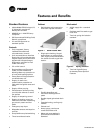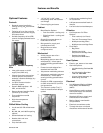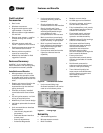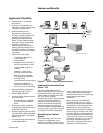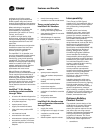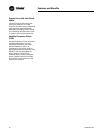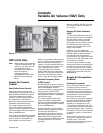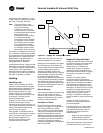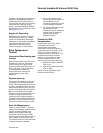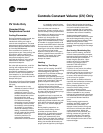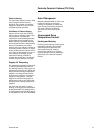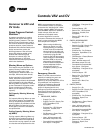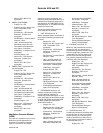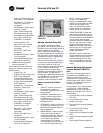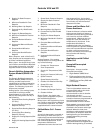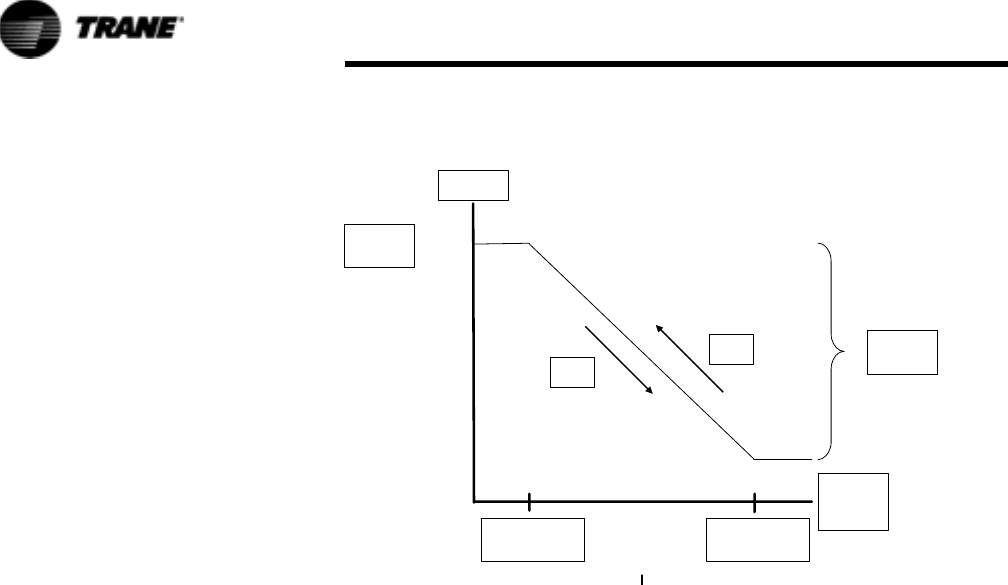
12 RT-PRC031-EN
Controls Variable Air Volume (VAV) Only
temperature from setpoint, i.e., the
further away from setpoint, the faster
the fresh air damper will open.
Note: The economizer is only
allowed to function freely if
one of the following
conditions is met. For dry
bulb economizer control the
ambient temperature must be
below the dry bulb
temperature control setting.
For reference enthalpy
economizer control, outdoor
air enthalpy must be below
the enthalpy control setting.
For comparative enthalpy
economizer control, outdoor
air enthalpy must be below
the enthalpy of the return air.
The outdoor air dampers may be set
for a maximum of 25 percent outdoor
air, through the unit mounted Human
Interface Panel or a signal from the
BAS/network, if the air handler is
equipped with 0 to 25 percent
motorized fresh air dampers.
A temperature sensor, located on the
entering air side of the chilled water
coil, will send a signal to the hydronic
valve to drive it full open when a
potential freeze condition is detected.
The supply fan is then turned off and
the fresh air damper is closed.
Heating
Modulating Gas
Upon a call for heating, the HEAT
module closes the heating contacts,
beginning the firing sequence. First,
the heat exchanger combustion
blower begins operation. Upon
positive proving of combustion
airflow, a 60 second pre-purge cycle
is executed. Then the ignition
sequence takes place.
If ignition is not proven, the safety
control locks out and must be
manually reset. As long as there is a
call for heat, the safety control can be
reset, which starts another purge
cycle and try for ignition.
Once ignited, as additional heat is
required, the combustion air damper
opens, increasing the firing rate.
During heating operation, an
electronic flame safety control
provides continuous flame
supervision. If combustion should
become unstable for any reason,
heating will automatically shut down
and be locked out until reset at the
unit mounted Human Interface panel.
As the heating requirement is
satisfied, the HEAT module will
modulate the combustion air damper
closed and the firing rate will lower
to maintain the desired outlet
temperature. When the requirement
is fully satisfied, the heating contacts
are opened, de-energizing the heat.
The specific sequence of operation of
the gas heat will depend on the size
of the heat exchanger.
Electric Heating
The individual stages of electric heat
will be sequenced on the zone
demand. The number of available
stages will depend on the unit size
and heat capacity selected.
Hot Water or Steam
On units with hot water or steam
heating, the supply air temperature
can be controlled to a heating
setpoint during the Occupied mode.
The supply air temperature heating
setpoint and deadband are user-
defined at the Human Interface Panel.
VAV Occupied heating on hot water
and steam heat units is enabled by
closing a field-supplied switch or
contacts connected to an changeover
input on the RTM.
Figure 12. Supply Air Temperature Reset
Ending (Cooling)
Beginning (Heating)
Reset Temperature
Beginning (Cooling)
Ending (Heating)
Reset Temperature
Supply Air
Temperature
Setpoint
Supply Air
Temperature
Outdoor Air
or
Zone
Temperature
Cooling
Reset
Heating
Reset
Amount of
Temperature
Reset
Supply Air Setpoint Reset
Supply air setpoint reset can be used
to adjust the supply air temperature
setpoint on the basis of a zone
temperature or on outdoor air
temperature. Supply air setpoint
reset adjustment is available from
the Human Interface Panel for supply
air heating and supply air cooling
control.
Outdoor air cooling reset is
sometimes used in applications
where the outdoor temperature has a
large effect on building load. When
the outside air temperature is low
and the building cooling load is low,
the supply air setpoint can be raised,
thereby preventing subcooling of
critical zones. This reset can lower
usage of primary cooling, thus
savings in mechanical cooling kw,
but an increase in supply fan kw may
occur.
Outdoor air heating reset is the
inverse of cooling, with the same
principles applied.
For both outdoor air cooling reset
and heating reset, there are three
user-defined parameters that are
adjustable through the Human
Interface Panel.
– beginning reset temperature
– ending reset temperature
– amount of temperature reset
Zone reset is applied to the zone(s) in
a building that tend to over cool or



